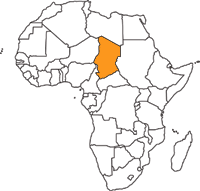 |
National Parks
- Aouk
- Goz-Beida
- Manda
- Zakouma
Wildlife Reserves
- Abou Telfane
- Bahr Salamat
- Beinamar
- Binder-Léré
- Fada Archei
- Larmanaye
- Mandelia
- Ouadi Rimé-Ouadi Achim
- Siniaka-Minia
Protection Forests
- Bebo
- Deli
- Djoli Kera
- Dora Kagui
- Haut Bragoto
- Helibongo
- Lac Ouei
- Siagon Yamodo
- Timberi
- Yamba Berete
Reforestation Areas
- Abeche
- Ahmadji
- Baibokum
- Bokoro
- Bongor
- Doba
- Gagal
- Kelo
- Koundoul
- Lere
- Massaguet Sylvopastoral
- Moundon
- Pala
Other Areas
Wetlands of International Importance (Ramsar)
- Lac Fitri
- Partie tchadienne du lac Tchad
|
Protected Areas in Chad
The first legislation providing for protected areas was passed when Chad was one of the four constituent territories of French Equatorial Africa, established under French colonial rule.
The authority responsible for conservation policy, and exploitation and protection of natural resources is the Ministry of Tourism, Water and Forests (Ministère du Tourisme, des Eaux et Forêts). This Ministry is also responsible specifically for both national parks and faunal reserves.
Government conservation objectives include reinforcing the national parks administration to enable it to protect wildlife and in particular fight against poaching.To achieve these aims the administration needs to provide well-trained and equipped park guards. Main tasks involve: protection against bush fires, pastoralists and cultivators; rigorous application of regulations concerning the ivory trade; public awareness programmes to increase understanding of the fauna; development of a national policy for the protection and management of fauna, by the creation of a national committee for nature protection and the prevention of poaching.
In general, there appears to be a firm commitment to nature conservation at all levels, with renewed management efforts within some protected areas, and an increase in anti-poaching activity. Hunting safaris, once a major reason for the reduction of wildlife particularly in the north of the country, are no longer listed as a significant factor. As in many developing countries, however, there has been an unfortunate lack of both equipment and personnel, hence management of protected areas has not been effective.
Sources: World Database of Protected Areas, UNEP-WCMC
|
|


